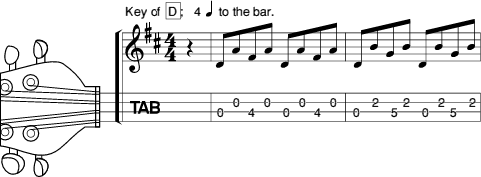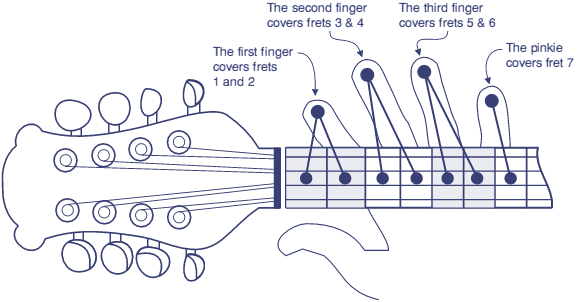|
|
|
Mandolin Tutorials
3) Tablature
|
|
Tablature and Notation
THERE ARE TWO MAIN METHODS of notating music for mandolin: standard or staff notation (of which everybody has seen examples) and tablature. The musical examples I'll be using in this tutorial will use both staff notation and tablature (or TAB as it's often called). For a beginner, tablature is a simple method of learning tunes, but it's a good idea to look at the corresponding staff notation even if you don't understand it. Slowly you'll see how the notes rise and fall, and it will begin to make sense. While reading tab it's also good to look at the music to get an idea of how long the notes last.
Tablature
 In the example on the right, the tablature is given below the standard notation. The
four lines of the tab correspond directly to the four courses of strings on your mandolin. If you were to tilt the mandolin so that you were facing the fretboard, the first or top string would be the E, the second A, third D and fourth or bottom string would be the G. Now look at the tablature: the top line is the E string, the second line the A, the third the D and the fourth line is the G. In the example on the right, the tablature is given below the standard notation. The
four lines of the tab correspond directly to the four courses of strings on your mandolin. If you were to tilt the mandolin so that you were facing the fretboard, the first or top string would be the E, the second A, third D and fourth or bottom string would be the G. Now look at the tablature: the top line is the E string, the second line the A, the third the D and the fourth line is the G.
The numbers on the lines indicate the fret on which you are to place your fingers. The first number on the tab in the example is "0" and it is lying on the third line down, the D string. This means that you simply pick the D string without placing your finger on any fret. When you play a string like this it is called playing it open; in this example you have just played an open D string.
The next number along is another "0", but this time it's on the second line, so play an open A string. Next is a "4"; place your middle finger on the D string at the fourth fret. The next three use open strings, first A, then D, the A again. See if you can play the rest of the example following the tablature.
Fingering
It is important that you use the correct fingering when you play
individual notes. The index finger plays the notes which occur in the
first two frets; the middle finger plays notes which occur in frets three and four; the ring finger frets five and six, and the pinkie fret seven.

In the tablature example below, the number "4" indicates that the note is to be played on the fourth fret on the D string, therefore it should be played with the middle finger. This very soon becomes second nature.

What about frets above the seventh? When you use the first seven frets it's called playing in the first position. When you move above the seventh fret, you get into the second position, then the third, and so on. This is often referred to as playing the positions, and it's rather more advanced than our stage. Almost all Scottish and Irish tunes simply use the first position, and none of the tunes we will be looking at go above the seventh fret.
The majority of tunes on this site come withmandolin tablature options. Go to the Tunes section and have a look at some of them. Try to pick out a few of the notes using the method described above.
|